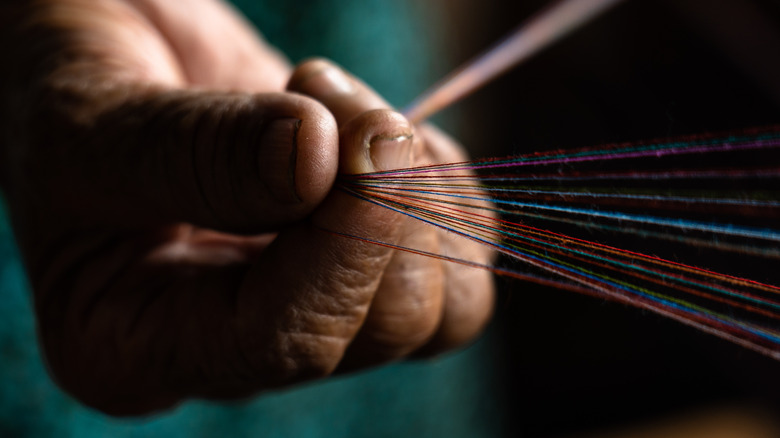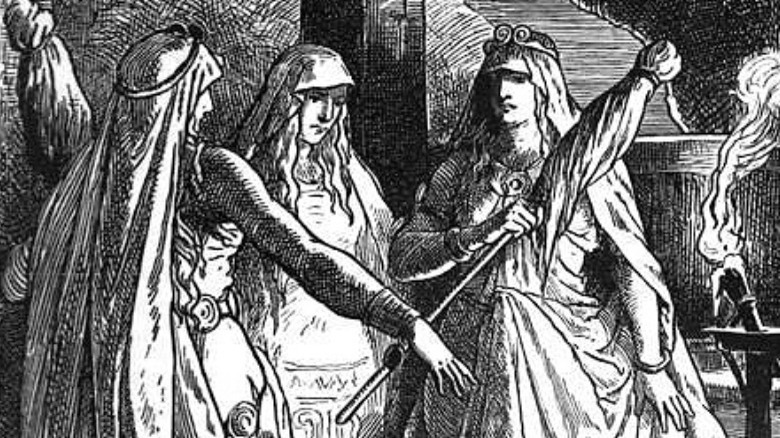What Is The Norse Pagan Web Of Wyrd?
The notion of a "web of fate" is not anything new. At minimum, what better way for people across time to express frustration with the sticky entanglements of class and wealth, culture and religion, and any other pressure causing folks to conform to undesired choices? Also, what better way explain the goings-on of the natural world on which hunters and farmers relied for life?
This is a good launching point for understanding the Norse pagan "Web of Wyrd," from which we get the modern word "weird." In the Web of Wyrd, described on sites like History of Vikings, choices made in one place affect what happens elsewhere. Nordic societies, like modern-day heathens, pointed to "omens," considered reverberations along Wyrd's plucked net of cause and effect. The science-savvy might recognize a modern analog in "non-local quantum entanglement," a way in physics to describe how one-half of a quantum particle pair need not exist nearby; it could pop up somewhere else.
The "Web of Wyrd" is the inspiration for the "Weird Sisters" Shakespeare referenced at the beginning of "Macbeth," who prophesy to the doomed king-to-be. The ancient Greeks and Romans also believed the exact same thing. In Greece the three sisters of fate were the Moirai (Clotho, Lachesis and Atropos), and in Rome, the Parcae (Nona, Decima, Morta). In Norse myth, they're Wyrd, Verdandi and Skuld. This leads some folks to wonder whether or not the stories have a common origin.
The Norns: three sisters of Fate
The Web of Wyrd, also called "Skuld's Web" (or "Skuld's Net"), was a critical component of Nordic society, which hailed from modern day Scandinavia (Norway, Sweden, and Denmark). Folks believed that the three sisters of fate, the Norns (Wyrd, Verdandi and Skuld), wove the path of life before birth, as Norse Mythology explains. Certain events were inescapable, and fate was as blind as it was apathetic. High or low, noble or peasant, the Norns — ancient entities distinct from the gods — wove as they wished. Even "Beowulf," the Anglo-Saxon oral tale written down about 1000 CE, contains references to Wyrd, translated as "fate" or "destiny." Beowulf speaks of how it's his "Wyrd" to fight the monster Grendel, saying, "Fate often spares an undoomed man when his courage avails" (as translated on Research Gate). This is similar to "Fortune favors the bold."
Belief in Wyrd wound up in England because of the Vikings, those boat-riding pillagers and traders most active during the "Viking Age" (roughly 800-1050 CE, per the National Museum of Denmark). They traveled out to Anglo-Saxon England, Scotland and France, Iceland and Greenland, eventually North America, and practically everywhere in between. Their impact was so pervasive that we even preserve the names of the Norse gods Tyr, Odin, Thor, and Freya in our days of the week: Tuesday, Wednesday, Thursday, and Friday. The Old Norse language got grafted onto Old English.
An interwoven runic symbol
Norse society expressed the Web of Wyrd as a runic symbol, similar to the runes Odin descried as he hung upside down on the world tree Yggdrasil, as Norse Mythology recounts. As History of Vikings explains, the form and function of the Web of Wyrd, and its symbol, are likely related to Yggdrasil, which represents the interconnectedness of all life. The nine realms of existence grew from Yggdrasil, as Skyalden relates: Midgard for humans, Asgard and Vanaheim for the gods, Jotunheim for the giants, and so forth. Wyrd's symbol, which contains nine lines (nine was a sacred Norse number), six points, and tons of overlapping triangles, represents how "the phases of our life were interconnected and impossible to separate," says History of Vikings. It's easy to see how the symbol looks like either a mesh of branches or a weave of fabric.
It's also no accident that the Norns — the fates — are portrayed as women weaving. A wife might have woven a tapestry depicting the desired outcome of her husband's upcoming battle, for instance. The word "Wyrd" is also a feminine noun, per History of Vikings, from the verb "weorþan," or "to come to pass." As Symbol Sage describes, we have a clear depiction of Norns weaving Wyrd in the poem "Völundarkvik" from the 13th-century Poetic Edda, a compilation of Norse myth. In it, maidens sit along the shore spinning yarn.


